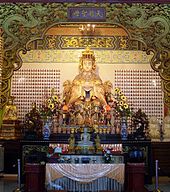- Temple (Chinese)
-
A Chinese temple can refer to any temple which is used for the practice of Chinese folk religion, a conglomeration of China's three main religions: Buddhism, Taoism, and Confucianism. Chinese Buddhist temples are different from these temples, most of which also act as a monastery.
Inside a typical temple, it is considered quite common to see elements of Buddhism and Taoism mixed together. A statue of Guan Yin may be present alongside traditionally Taoist deities such as the Jade Emperor or Mazu.
Chinese temples are also a common sight outside of Mainland China, including most parts of East Asia and across the world where there is a plurality of Chinese-descent residents.
Architecture
Chinese temples are usually red in color, although gold ones exist as well. The architecture is traditionally Chinese in style, and they are decorated extensively with sculptures and sometimes traditional Chinese paintings. Larger temples may be built as a compound, with an outer wall and often a courtyard. In the courtyard there may be a chimney-like structure made of bricks, or this may be located outside the temple. This is used for burning joss paper to the gods, ancestors or spirits. The temple may include a section for burning large incense coils. Over the entrance of the temple compound there will be a plaque with the name of the temple in Chinese (usually the characters are read from right to left).
At the entrance to the main temple area, there will be a large container for burning joss sticks or incense. It will generally be filled with ash, and it is into the ash that the incense or joss sticks are placed. In some temples, however, the incense burner may be placed further inside. If the incense burner is placed on a table, oil lamps may be placed beside the incense burner, to allow worshippers to light the incense. If the incense burner is free-standing there will generally be a table in front of it with a lamp to light the incense from. Some temples have three or more incense burners. There may also be holders for stick candles, and "wish candles" may be placed in front of the incense burner.
On the far wall of the temple will be placed the main shrine. There are usually three main shrines in a temple, and there may be smaller ones as well in other parts of the temple. For example, the Thean Hou Temple in Kuala Lumpur has three shrines: One to Shui Wei Sheng Niang, the waterfront goddess, one to Mazu, the sea goddess, and one to Guan Yin, the benevolent goddess. The altar is usually made out of wood, and it usually has several different levels, with the statue placed on the highest one. Usually two vases of flowers will be placed in front of and to the side of the statue. Offerings of fruits are placed on the altar, arranged in a pyramid shape. Oil lamps are also placed on a lower level of the altar, and typically consist of a glass filled with oil, with a wick placed in a cork floater. Sometimes the statues are placed in glass-fronted cabinets, and wooden tables are placed in front of them to hold the required paraphernalia. Padded cushions for kneeling are usually placed in front of the altar.
Worship
Worship in Chinese temples usually consists of making offerings to the various gods, spirits and ancestors. The main act of worship is lighting incense or joss sticks. These are generally provided to worshipers by the temple in exchange for a small donation. Worshipers generally take three or nine incense sticks and light them from an oil lamp placed beside the burner. They hold the incense sticks in both hands while bowing the head and present them as an offering to the god(s) in the temple. Larger incense sticks called joss sticks are also used in worship. Candles are also lit to the various gods. These candles are red and are made with a stick down the middle, and the stick is placed in special holders beside the incense burner, which consist of metal trays with holes in them. Larger "wish candles", which are generally colourful and made in the shape of a flower, may also be lit, and they are usually placed on a table in front of the incense burner. These are generally used in the same way that votive candles are used in Roman Catholic and Eastern Orthodox worship.
The burning of joss paper is also practiced in Chinese temples. There is a special chimney-like burner for this, either situated outside the temple or, if the temple is big enough, in the temple courtyard before the main temple.In these temples there are usually candles placed there for many special reasons.
External links
Categories:- Chinese traditional religion
Wikimedia Foundation. 2010.


